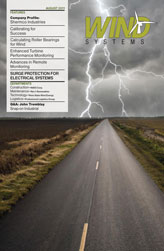The basic design criteria for wind generator installations—that they are placed in large open areas, mounted on tall towers, and not influenced by other nearby structures—also places them at very high risk of being affected by lightning issues. This risk becomes even greater when installations are in high flash density regions such as shown on the map in Figure 1.
Lighting may cause the catastrophic damage shown in Figure 2, where a direct strike to a blade occurs, but more commonly occurring effects and probably less noticeable ones may be those caused by a nearby strike to ground, or “cloud to cloud” discharge. Statistics on this subject show that of all lightning damage to wind generators only about 10 percent involve blades, while approximately 85 percent affect the power, control, and communication systems.
These events may cause severe equipment damage, but they will also cause less-obvious damage including premature component failure and interference of critical communication and control signals, all of which results in a disruption of service and loss of generation (revenue).
Ground Potential Rise
Wind generators that are installed in high-risk lightning environments should have lightning protection systems incorporated in their mechanical design, which would include air terminals on the nacelle, receptors in the blades, adequate down conductors, and a proper grounding system. This system would protect the wind generator from the physical damage of a direct strike by providing a safe and effective path to earth for the discharge current. It would not eliminate the effect the lightning would have on the electrical system, however.
Assuming that (external) lightning protection is installed and the generator is not mechanically damaged by a direct strike, the electrical system remains vulnerable to high voltage transients that may appear on the power, control, and communications systems. These transients, also referred to as surges, will involve these systems by being electromagnetically induced, entering the system through grid connections or by differences in the ground reference that are connected by utility circuits; specifically a substantial Ground Potential Rise (GPR) of local earth with regard to distant earth. The latter is caused by a local strike or strike to the structure, and the resulting local GPR as the lightning current dissipates as it travels through the earth’s impedance and at the same time being connected to a distant ground reference through the utility grid. Figure 3
Regardless of the cause of these voltage transients on the system, they will have a very damaging effect as they appear at the terminals of key pieces of equipment, since they will be of voltages magnitudes many times greater than what the equipment was designed for. While the transients are short lasting, from some tens of microseconds to less than a millisecond, they have high energy content during that short time and can produce insulation breakdowns with discharge currents of tens of thousand of amperes, occurring in multiple locations.
The most commonly used representation of the wave shapes for describing the characteristics of a lightning and surge current discharge is the 8/20 microsecond and 10/350 microsecond curve, where the later is associated with direct lighting strikes. One can easily see that even if the magnitudes are equal, the greater duration of the 10/350 µs wave has approximately 25 times the energy than the 8/20 µs.
Surge Protection Devices
The strategic placement of Surge Protective Devices (SPD) mitigate these issues as they function as either shorting or voltage clamping devices minimizing that transient voltage that would have otherwise appeared at the equipment terminals. These devices are applied between the energized conductor and ground and must be connected close to the terminals of the equipment they are intended to protect, and using the shortest and straightest routed conductors of sufficient cross-sectional area. Not implementing this design criterion will result in a higher than necessary voltage drop in the SPD circuit during the discharge that will expose the “protected equipment” to higher transient voltages than necessary.
The selection criteria is based upon the device’s ability to change states quickly enough for the brief time the transient is present, to be able to discharge the magnitude of the transient current that is associated with the transient voltage and without failing, and to do so minimizing the voltage drop across the SPD circuit so as to protect the equipment it is connected to, and to not interfere with the normal function of that circuit.
The most commonly used component for SPD application is the Metal Oxide Varistor (MOV) that functions as a voltage-clamping device. Other components are also used for SPD applications such as Silicon Avalanche Diode, controlled Spark Gaps, and Gas Discharge Tubes, with the latter two being switching devices which appear as short circuits or crowbars during their operation. Each technology has its own characteristics, making it more or less suitable for a specific application.
Figure 4 shows a table listing the basic characteristics of each of the primary components. These components are used to make a completed SDP that will include an insulated enclosure, terminals for connecting conductors, safety disconnection mechanism, status indications, and other features. Figure 5
Combinations of these devices can also be paired and coordinated so as to provide more optimal characteristics than they would offer individually. Figure 6 shows an example of two coordinated SPDs; a Spark Gap- and MOV-based technology that together are able to both discharge high energy lightning currents and clamp the residual voltage to an acceptable protection level.
AC Surge Protection
Lightning flashes from cloud to the lightning protection system, the wind generator structure, or a nearby ground will cause a local GPR with regard to distant ground references. Conductors spanning these distances will expose equipment to these significant voltages. The effects of these ground potential rises are primarily seen where a grid tied system is connected to the utility at the service entrance, since it is this intertie that connects local ground to a distant referenced ground. Surge protection should be placed at this location primarily to protect the service entrance side from damaging transients. The transients seen at this location are of the higher magnitude and duration (10/350 µsec versus 8/20 µsec), and therefore must be managed by surge protection with appropriately high discharge current ratings. Spark gaps in coordination with MOV SPDs are the ideal solution. The Spark Gap technology has the ability to discharge the high “lightning currents” providing an equipotential bonding function during the occurrence of the lightning transient, and coordinated MOV has the ability to clamp the residual voltage to an acceptable level for the equipment it is to protect.
In addition to the use of these coordinated Spark Gap/MOV SPDs at the service entrance, properly rated MOVs should be at critical locations within the generator system to mitigate the effects of induced lightning transients and internally generated switching transients.
Non-Power System Surge Protection
Just as power system equipment and components are susceptible to the affects of lightning, so is the equipment found on measurement and control, instrumentation, SCADA, and communication systems associated with these installations.
The basic concept of SPD protection is the same as on power circuits, but the equipment is usually less tolerable to overvoltage impulses and more susceptible to erroneous signals and to being adversely affected by the addition of series or parallel impedances to the circuits. Greater considerations must therefore be given to the characteristics of each SPD that is added to such circuits. Whether these components are communicating through twisted pairs, CAT 6 Ethernet, or coaxial RF, SPDs are available for these systems as well. As an example, when selecting SPDs for these circuits consideration must be given to their ability to discharge the transient currents without failure, provide an adequate voltage protection level, and have other unique characteristics so as not to interfere with the system’s function including series impedance, line to line and ground capacitance, and frequency bandwidth, etc.
Conclusion
In spite of the high lightning risk that wind power system installations are exposed to, they can be protected by the application of Surge Protection Devices and Lightning Protection Systems. Regarding SPDs, one must give thoughtful and careful consideration to the placement of the SPD on the system and what they are intended to protect, the connection from the system to the SPDs, and the proper bonding of all grounded members and the ground system. Also check for the adequate discharge rating of the SPD, the voltage protection level the SPD provides, the suitability of the SPD for the system it is applied to, and consideration to failure mode of SPDs and status indication. Also be mindful of local and remote status indication and easily replaceable modules, and the suitability of SPDs on systems so as not to affect normal system function, specifically on non-power systems.








































